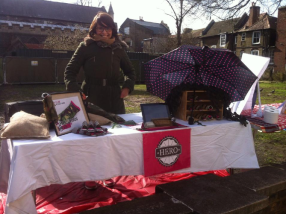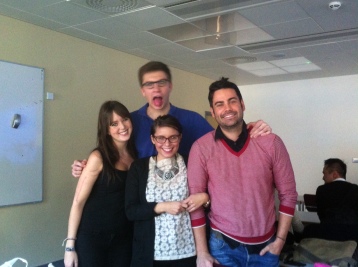Time spends so quickly, and particularly this year.
I still remember 8 months ago, the excitement I felt about moving to London, and starting this MA in Advertising and the creative economies. After a year abroad in Australia, I was not really scared about living far (not that far actually…) from home one more year, in an English-speaking country. I knew that this year would be full of surprises, nice people and amazing experiences. This year was even better than what I expected. When I started my bachelor degree in communication studies, I did know this would be a wonderful field I wanted to work in, but I had no more specific ideas about my future professional goals. My last year of bachelor in Australia confirmed to myself that I wanted to work in something creative. I always liked human psychology, the communication classes undertook during my bachelor and what can actually be linked to these two things and requires creativity at the same? Advertising. My background allowed me to specialize into advertising and start the MACE degree with a major in Advertising. My goal is to work in this industry and this master allowed me to gain new skills, and confirm this idea.
Social media
I have always been on Facebook, Instagram or even Myspace when it started and quite enjoyed it. Ok, I even have to admit that I am kind of addicted to it. But there are some I do not use, and one of those is Twitter. At the beginning of the year, when it was said we have to be on Twitter and improve our social media reputation, I honestly was not really happy with that. Before that, I never got any interest in Twitter. It is like a vegetable that seems weird and not good but as soon as you try you like it. Well, it was this kind of thing to me. I am happy of having been “forced” to use this social network and I know now how it will be important for my future. The advertising field is constantly evolving, some academics are even going so far to say that it is now a new element of the marketing communication mix ( Mangold and Faulds, 2009). And Twitter is the kind of thing I’m saying to myself “I should have start earlier”… Anyway, as the saying goes, late is better than never. So I have to admit that at the moment, I’m not this famous person on Twitter, I have nothing to be famous of actually. BUT, hopefully it may help me to achieve my future goal. On one hand, Twitter is “doing by learning”. It is then better that I start practising this year, how to tweet and what to tweet about. Twitter is completely different than Facebook and other social media. Each social media platform has its own purposes (Nahai, 2012). On the other hand, it will help me to create a network and also show what I am interested in. If a potential employer will look at my account, he will notice that I am following the news, and particularly interested in the advertising current topics. With Hero, we wanted to be on social media to generate consumers’ engagement. each platform had a specific purpose. As Rampton (2014) points out, it is important to be on social media for a company but it has to be a clearly defined strategy, with goals and purposes. If not, it can be really bad for the brand. This is on Twitter, we focused on creating a network around the company, but also took the opportunity to tweet about news of the company but also heroes’ story, what was part of our strategy. Facebook was used to create users’ engagement via comments, pictures, stories, etc. Also, from the class perspective, and particularly in Interactive Marketing Communication, the idea that social media is a wonderful but dangerous tool for company was confirmed throughout the use of case studies and examples. I know that in my future job I will have to use social media and will have to keep in mind what I learnt this year, and hopefully I will use it successfully… The point is that within the web 2.0, “any participant can be a content creator” users were only “consumers of content” before (Cormode and Krishnamurthy, 2008).
Creative leadership
To me, creative leadership was one of the most interesting classes I have ever had, and I definitely think we should have more classes like this one. It is the kind of course that will definitely be useful not only in my everyday life, but also in my future professional life. Whatever will be my job, I hope that the boss will apply creative leadership, and I will definitively use it as soon as I have the opportunity.
“The creative leader is not someone who tell people what to do. The creative leader creates conditions […] and a culture where everyone can have ideas.” (Sir Ken Robinson, 2011).
And this is what is needed today. Because of the globalisation, the time-space compression due to new communication technologies, multiculturalism is everywhere. The MACE is a proper representative of multiculturalism. There are about 20 different nationalities for less than 30 people!
According to some, the cultural economy seems to be like a boundary between “culture, economics and technology” (BOP consulting, 2010, p.11). So it seems that nothing would be more appropriate than creative leadership in order to enhance creativity. I really enjoyed the workshop we had with Piers Ibbotson. It allowed me to learn about myself, and it confirmed the idea about how it is important to listen to each other, leader or led. We practised some simple exercises such as the game of the mirror, in pair one person had to do the same movement as the other. One was announced led and the other one the leader. But at one moment, the led should lead the movement rather than the leader, and the goal was to make this change in a really natural way. This exercise illustrates the idea that a creative and great leader is someone who “recognizes that they will not be able to solve all of their critical challenges alone and that they need a lot of help” (Basadur, 2004, p.120). We had a lot of exercices of this genre and it kind of stroke me “Why do companies do not offer this kind of workshop automatically?”. It is true that companies want creativity and innovation from their employees, but if they do not set up an environment favorable to creativity, nothing would come. I will still have in mind this workshop, in my personal or professional life. I know that if one day I have to manage a team I will not hesitate to make this kind of workshop. Not only people gain to know from each other, but it also enhances teamwork and creativity. Creative individuals need an infrastructure proper to allow creativity, and it can and has to be taught to leaders of today and tomorrow (De Pree, 2011).
Designing a Business
Finally, one of the most useful modules of the MACE program was designing a business. I do not really have any experiences in the advertising field, and I know it is a drawback for me in a world were experience is sometimes more important than degree (Hellyer, 2012). It is not that I did not want to, but unfortunately internship are generally not paid and I needed to earn some money during my summer job. I was happy in Australia to achieve a creative portfolio, made of artistic video and other creative artwork. But thanks to designing a business, I can definitely talk about my “job experience” during an interview. There are so many aspect of a real life professional experience I can talk about. First, team work, that was really enjoyable. It is really rare when you find a group in which you feel completely at ease so everyone is listening to each other, giving their own ideas. There was such a great group cohesion, and this is then that you can notice how important it is to behave in an assertive way in order to maximize the benefits of group meetings. Collaboration was one of the key aspects of our team, and I can definitely say that it is linked to creativity. Alex Osborn developed a brainstorming business model in which individuals have to throw all the ideas that comes to mind, in a non-judgmental environment (Barron, 2013). This was the case for our team, but unfortunately it is not always the case. This is why I will always keep in mind that as a team member, I will have to encourage my peers to express themselves, to show them I will never judge any ideas. Also, we faced some problem together that I can definitely talk about during an interview. For instance we took conscious of the importance of weekly meetings that allowed us to not be in a rush, working regularly and thus being efficient because we had time to put things into perspective. Brainstorming was really useful for us and we really get this idea that nothing is stupid and all ideas have to be considered. Something that you think can be stupide may actually be a good start for the creative idea of the year! Then, the fact that we faced critics together and turned it into opportunities to get better was possible because we did not hesitate to reassess our work and accept negative comments. The fact of not being alone at this moment was quite good because we really felt the “team spirit” that allows people to get better and better. Finally, it is all the aspect of the business that will be useful to me in my professional future. I already knew a bit about the importance of storytelling in marketing but then we had the chance to apply it. Professionals agree to say that “content must be emotionally driven, describe the brand positioning and communicate the differentiating factors about a product” (Williams, no date) in order to win the market and remain throughout ages. This is what we did with hero. We decided to take this business really seriously and we added a real story telling to our umbrella bag. The main thing was the fabric the product is made from: ponchos used by the British army and that would have been throughout away. The name came out really simply with a logical tagline explaining that it protected our soldiers, now it protects your belongings but also the planet (by upcycling). Because of the importance of the storytelling, Hero became an upcycled brand, a social enterprise and no longer only a product.
References
Barron, C. (2013) ‘Creativity and Collaboration’, Psychologytoday.com, 30 March.
Basadur, M. (2004) ‘Leading others to think innovatively together: Creative leadership’, The Leadership Quarterly, 15(1), pp.103-121.
BOP Consulting (2010) Mapping the Creative Industries: A Toolkit. London: British Council.
Cormode, G., and Krishnamurthy, B. (2008) ‘Key differences between Web 1.0 and Web 2.0’, First Monday, 13(6).
De Pree, M. (2001) ‘Creative leadership’, Leader to Leader, 20, pp.10-13
Hellyer, P. (2012) ‘Decades of Experience Mean More than an Old Diploma’, Thenational.ae, 11 September.
Mangold, W. G., and Faulds, D. J. (2009) ‘Social media: The new hybrid element of the promotion mix’, Business horizons, 52(4), pp.357-365.
Nahai, N. (2012) Webs of Influence: The Psychology of Online Persuasion. Edinburgh: Pearson Education Limited.
Rampton, J. (2014) ‘Why Most Social Media Strategies Fail’, Forbes.com, 22 April.
Robinson, K. (2011) Creative Leadership [Video Online] Available at:https://www.youtube.com/watch?v=KAGHCwlfh-o (Accessed on: 25 April 2014).
Williams, D. (no date) ‘No Story? No Brand. Transparent Storytelling in Marketing Helps Brands Win’, Sproutcontent.com.



















